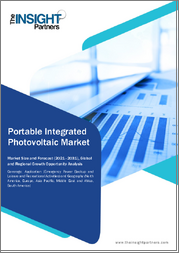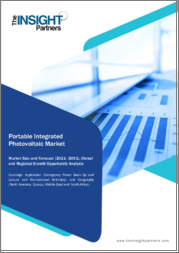
|
시장보고서
상품코드
1528926
건물일체형 태양광발전(BIPV) 시장 규모 : 제품 유형별, 용도별, 최종 이용 산업별, 지역별 전망, 예측(2024-2032년)Building Integrated Photovoltaics (BIPV) Market Size- By Product Type (Crystalline Silicon, Thin Film), By Application (Roof, Wall, Facades, Windows), By End-use Industry (Residential, Commercial, Industrial), Regional Outlook & Forecast, 2024 - 2032 |
||||||
건물일체형 태양광발전(BIPV) 시장 규모는 2024년부터 2032년까지 연평균 20% 이상의 성장률을 기록할 것으로 예상되며, 그 원동력은 출시 증가와 기술 발전으로 인한 것으로 분석됩니다.
최근 기업들은 에너지 효율이 높고 미관이 뛰어난 구조물을 만들기 위해 태양광 패널을 건축자재에 통합하고 있습니다.
건축가와 엔지니어들은 지붕, 파사드, 창문과 완벽하게 조화를 이루는 혁신적인 건물일체형 태양광발전(BIPV) 솔루션을 개발하고 있습니다. 건물이 보다 지속가능한 방향으로 진화함에 따라, 설계자들은 에너지 생산을 극대화하고 탄소 배출량을 줄이기 위해 신축과 개보수 모두에 BIPV를 통합하고 있습니다. 예를 들어, 2023년 3월, GoodWe는 갤럭시 시리즈를 출시했습니다. 갤럭시 시리즈는 미관과 구조적 무결성을 유지하면서 에너지 효율을 높이기 위해 태양광 기술을 건축자재에 도입한 완전히 새로운 초경량 BIPV 솔루션입니다.
BIPV 산업은 제품 유형, 용도, 최종 사용 산업, 지역으로 구분됩니다.
박막 제품 유형의 시장 점유율은 유연하고 가벼운 태양광 솔루션에 힘입어 2032년까지 큰 폭으로 성장할 것으로 예상됩니다. 기술자들은 창, 파사드, 지붕 등 다양한 건축자재에 박막을 통합하여 디자인의 아름다움을 해치지 않고 원활한 에너지 생산을 실현하고 있으며, BIPV 박막은 에너지 출력을 높이기 위해 보다 효율적인 태양광 소재 및 첨단 기술과 결합하고 있습니다. 결합됩니다.
용도별로는 건물 옥상에 태양광 패널이 점점 더 많이 설치되고 있어 2024년부터 2032년까지 지붕에 태양광 패널을 설치하는 건물일체형 태양광발전(BIPV) 시장이 두드러진 수익을 창출할 것으로 예측됩니다. 엔지니어와 건축가들은 건물의 구조적 무결성을 유지하면서 재생 가능한 전력을 생산할 수 있도록 태양전지를 통합한 지붕을 설계하고 있습니다. 이러한 통합 시스템은 에너지 효율을 높이고 기존 전력 공급에 대한 의존도를 낮춥니다. 마지막으로, 보다 효율적인 태양전지 및 설치 방법의 개선과 같은 태양전지 기술 및 재료의 발전으로 BIPV의 대규모 도입이 더 쉽고 비용 효율적으로 이루어지고 있습니다.
유럽의 건물일체형 태양광발전 산업 규모는 도시화 추세와 스마트 시티화 추진으로 2032년까지 괄목할 만한 성장률을 기록할 가능성이 높습니다. 건축가와 개발자들은 에너지 독립성과 안전성을 높이기 위해 BIPV 솔루션을 건물 설계에 통합하고 있습니다. 이 기술은 건물 표면에서 직접 재생에너지를 생산함으로써 지속가능한 도시 개발에도 기여하고 있습니다. 유럽의 에너지 및 환경 목표 달성을 위한 BIPV의 지속적인 개발과 채택은 시장 성장을 결정지을 것으로 보입니다.
목차
제1장 조사 방법과 조사 범위
제2장 주요 요약
제3장 업계 인사이트
- 생태계 분석
- 벤더 매트릭스
- 이익률 분석
- 테크놀러지와 혁신 전망
- 특허 분석
- 주요 뉴스와 대처
- 규제 상황
- 영향요인
- 성장 촉진요인
- 재생에너지에 대한 주목 상승
- 정부 인센티브와 규제 정책
- 급속한 도시화와 스마트 시티 발전
- 넷 제로 에너지 빌딩(NZEB) 목표
- 아키텍처 유연성과 미적 통합
- 업계의 잠재적 리스크와 과제
- 높은 초기 비용
- 기술의 복잡성과 통합 과제
- 성장 촉진요인
- 성장 가능성 분석
- Porters 분석
- PESTEL 분석
제4장 경쟁 상황
- 소개
- 기업 점유율 분석
- 경쟁 포지셔닝 매트릭스
- 전략 전망 매트릭스
제5장 시장 추정과 예측 : 제품 유형별, 2021-2032년
- 주요 동향
- 결정 실리콘
- 박막
- 비정질 실리콘
- 텔루르화 카드뮴
- 구리 인듐 갈륨 셀렌화물
- 기타
제6장 시장 추정과 예측 : 용도별, 2021-2032년
- 주요 동향
- 지붕
- 벽
- 파사드
- 창
- 기타
제7장 시장 추정과 예측 : 최종 이용 산업별, 2021-2032년
- 주요 동향
- 주택
- 상업
- 산업
제8장 시장 추정과 예측 : 지역별, 2021-2032년
- 주요 동향
- 북미
- 미국
- 캐나다
- 유럽
- 영국
- 독일
- 프랑스
- 이탈리아
- 스페인
- 기타 유럽
- 아시아태평양
- 중국
- 인도
- 일본
- 한국
- 뉴질랜드
- 기타 아시아태평양
- 라틴아메리카
- 브라질
- 멕시코
- 기타 라틴아메리카
- 중동 및 아프리카
- UAE
- 남아프리카공화국
- 사우디아라비아
- 기타 중동 및 아프리카
제9장 기업 개요
- AGC Inc.
- Ascent Solar Technologies Inc.
- Changzhou Almaden Co. Ltd
- Dow Solar
- Ertex-Solar
- Hanergy Mobile Energy Holding Group Limited
- Heliatek GmbH
- Maxeon Solar Technologies, Ltd.(The Solaria Corporation)
- Merck KGaA
- Nanoflex Power Corporation
- NanoPV Solar Inc.
- ONYX Solar Group LLC
- Polysolar Ltd
- Tesla, Inc.
- ViaSolis
Building Integrated Photovoltaics Market size is expected to record over 20% CAGR between 2024 and 2032, driven by the increasing launches and technological advancements. Lately, companies are integrating solar panels into building materials to create energy-efficient and aesthetically pleasing structures.
Architects and engineers are developing innovative building-integrated photovoltaics (BIPV) solutions that blend seamlessly with roofs, facades, and windows. As buildings are evolving to become more sustainable, designers are embedding BIPV in both new constructions and retrofits for maximizing energy production and reduce carbon footprints. For instance, in March 2023, GoodWe launched its Galaxy Series, a brand new ultra-lightweight BIPV solution deploying solar technology into building materials for enhancing energy efficiency while maintaining aesthetic appeal and structural integrity.
The BIPV industry is segmented into product type, application, end-use industry, and region.
The market share from the thin film product type segment is expected to witness substantial growth through 2032, backed by their flexible and lightweight solar solutions. Engineers are integrating thin films into various building materials, such as windows, facades, and roofs for seamless energy generation without compromising design aesthetics. BIPV thin films are also incorporated with more efficient photovoltaic materials and cutting-edge technologies to increase energy output.
In terms of application, the building-integrated photovoltaics market from the roof segment is slated to generate notable revenue during 2024-2032, favored by higher adoption of solar panels into building rooftops. Engineers and architects are designing roofs with embedded photovoltaic cells to allow buildings to generate renewable electricity while maintaining structural integrity. These integrated systems are enhancing energy efficiency and reducing reliance on traditional power sources. Lastly, advancements in solar technology and materials, such as more efficient photovoltaic cells and improved installation methods are making it easier and more cost-effective to implement BIPV on a wide scale.
Europe building integrated photovoltaics industry size is likely to record a notable growth rate through 2032 driven by urbanization trends and the push towards smart cities. Architects and developers are integrating BIPV solutions into building designs to enhance energy independence and security. These technologies are also contributing to sustainable urban development by generating renewable energy directly from building surfaces. The ongoing development and adoption of BIPV towards achieving Europe's energy and environmental goals will also define the market growth.
Table of Contents
Chapter 1 Methodology & Scope
- 1.1 Market scope & definition
- 1.2 Base estimates & calculations
- 1.3 Forecast calculation
- 1.4 Data sources
- 1.4.1 Primary
- 1.4.2 Secondary
- 1.4.2.1 Paid sources
- 1.4.2.2 Public sources
Chapter 2 Executive Summary
- 2.1 Industry 360º synopsis, 2021 - 2032
- 2.2 Business trends
- 2.2.1 Total addressable market (TAM), 2024-2032
Chapter 3 Industry Insights
- 3.1 Industry ecosystem analysis
- 3.2 Vendor matrix
- 3.3 Profit margin analysis
- 3.4 Technology & innovation landscape
- 3.5 Patent analysis
- 3.6 Key news and initiatives
- 3.7 Regulatory landscape
- 3.8 Impact forces
- 3.8.1 Growth drivers
- 3.8.1.1 Increased focus on renewable energy
- 3.8.1.2 Government incentives and regulatory policies
- 3.8.1.3 Rapid urbanization and the development of smart cities
- 3.8.1.4 Net zero energy building (NZEB) Goals
- 3.8.1.5 Architectural flexibility and aesthetic integration
- 3.8.2 Industry pitfalls & challenges
- 3.8.2.1 High initial costs
- 3.8.2.2 Technological complexity and integration challenges
- 3.8.1 Growth drivers
- 3.9 Growth potential analysis
- 3.10 Porter's analysis
- 3.10.1 Supplier power
- 3.10.2 Buyer power
- 3.10.3 Threat of new entrants
- 3.10.4 Threat of substitutes
- 3.10.5 Industry rivalry
- 3.11 PESTEL analysis
Chapter 4 Competitive Landscape, 2023
- 4.1 Introduction
- 4.2 Company market share analysis
- 4.3 Competitive positioning matrix
- 4.4 Strategic outlook matrix
Chapter 5 Market Estimates & Forecast, By Product Type, 2021-2032 (USD Million)
- 5.1 Key trends
- 5.2 Crystalline silicon
- 5.3 Thin film
- 5.3.1 Amorphous silicon
- 5.3.2 Cadmium telluride
- 5.3.3 Copper indium gallium selenide
- 5.4 Others
Chapter 6 Market Estimates & Forecast, By Application, 2021-2032 (USD Million)
- 6.1 Key trends
- 6.2 Roof
- 6.3 Wall
- 6.4 Facades
- 6.5 Windows
- 6.6 Others
Chapter 7 Market Estimates & Forecast, By End-Use Industry, 2021-2032 (USD Million)
- 7.1 Key trends
- 7.2 Residential
- 7.3 Commercial
- 7.4 Industrial
Chapter 8 Market Estimates & Forecast, By Region, 2021-2032 (USD Million)
- 8.1 Key trends
- 8.2 North America
- 8.2.1 U.S.
- 8.2.2 Canada
- 8.3 Europe
- 8.3.1 UK
- 8.3.2 Germany
- 8.3.3 France
- 8.3.4 Italy
- 8.3.5 Spain
- 8.3.6 Rest of Europe
- 8.4 Asia Pacific
- 8.4.1 China
- 8.4.2 India
- 8.4.3 Japan
- 8.4.4 South Korea
- 8.4.5 ANZ
- 8.4.6 Rest of Asia Pacific
- 8.5 Latin America
- 8.5.1 Brazil
- 8.5.2 Mexico
- 8.5.3 Rest of Latin America
- 8.6 MEA
- 8.6.1 UAE
- 8.6.2 South Africa
- 8.6.3 Saudi Arabia
- 8.6.4 Rest of MEA
Chapter 9 Company Profiles
- 9.1 AGC Inc.
- 9.2 Ascent Solar Technologies Inc.
- 9.3 Changzhou Almaden Co. Ltd
- 9.4 Dow Solar
- 9.5 Ertex-Solar
- 9.6 Hanergy Mobile Energy Holding Group Limited
- 9.7 Heliatek GmbH
- 9.8 Maxeon Solar Technologies, Ltd. (The Solaria Corporation)
- 9.9 Merck KGaA
- 9.10 Nanoflex Power Corporation
- 9.11 NanoPV Solar Inc.
- 9.12 ONYX Solar Group LLC
- 9.13 Polysolar Ltd
- 9.14 Tesla, Inc.
- 9.15 ViaSolis



















